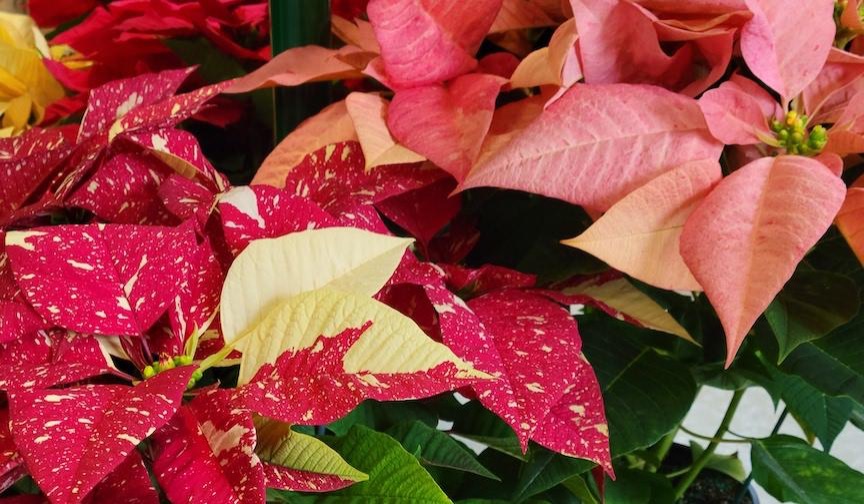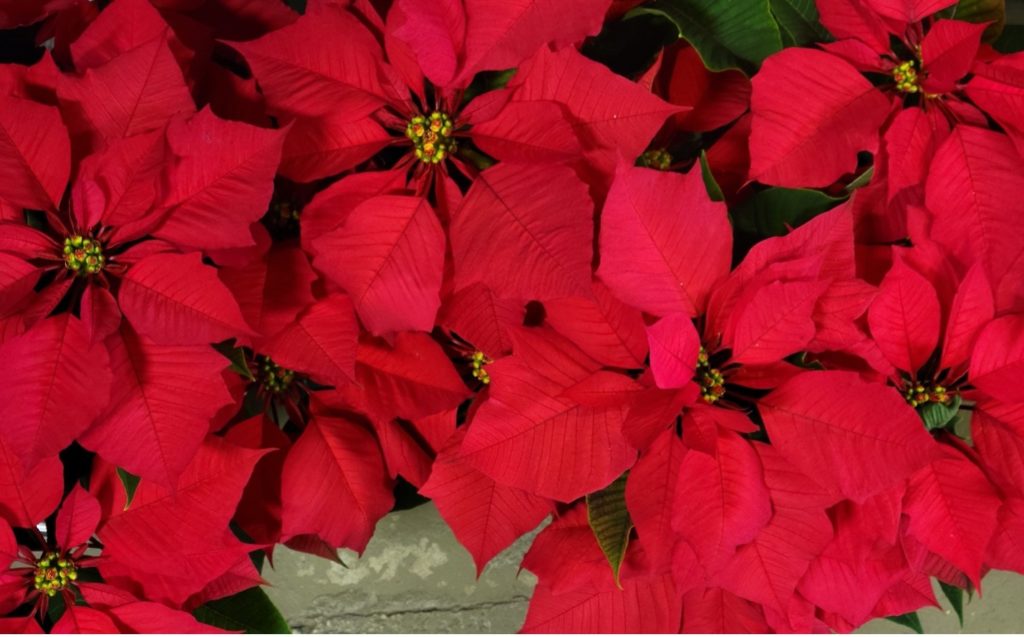-Pam Scott-
 This time of year, many of us are decking our halls with boughs of holly, evergreens, and the perennial favorite… poinsettias. I have to admit that in the past I have had a rather “whatever” attitude when it came to treating poinsettias as an indoor tropical houseplant. I love to use them to fill in spots that need seriously fabulous seasonal color in my home or as the perfect holiday gift to give to a friend or relative when I have no clue what to give them. I considered them as pretty much disposable after their holiday flash began to wane. Having grown up in a family that couldn’t throw out any plants that might have a chance of survival, however, we always had windows full of leggy poinsettias in different stages of impending death. There was always the promise of “maybe they will come back and bloom next year. This never, ever happened. We had no clue what they needed.
This time of year, many of us are decking our halls with boughs of holly, evergreens, and the perennial favorite… poinsettias. I have to admit that in the past I have had a rather “whatever” attitude when it came to treating poinsettias as an indoor tropical houseplant. I love to use them to fill in spots that need seriously fabulous seasonal color in my home or as the perfect holiday gift to give to a friend or relative when I have no clue what to give them. I considered them as pretty much disposable after their holiday flash began to wane. Having grown up in a family that couldn’t throw out any plants that might have a chance of survival, however, we always had windows full of leggy poinsettias in different stages of impending death. There was always the promise of “maybe they will come back and bloom next year. This never, ever happened. We had no clue what they needed.
The two questions we get the most from our poinsettia-buying customers are: “Will they poison my children and pets?” and “How do I get them to bloom again?”. While researching these questions I have found out some pretty interesting facts about poinsettias and all things Euphorbia-related that have led me to a newfound appreciation of them as houseplants.
Poinsettias (Euphorbia Pulcherrima) have been a staple of indoor winter holiday decor since the 1820s when Joel Poinsett introduced the plant from its native Mexico to Europe. Poinsettias belong to the Euphorbiaceae or Spurge family. This family of plants is shared with many common North American wildflowers as well as many popular tropical house plants such as Crotons, pencil cactus and crown of thorns, to name just a few. The Euphorbia family also includes many economically valuable plants such as Cassava, a major source of food in many countries, Caster oil plant, which is used medicinally as well as in the production of the lethal poison Ricin, and the Rubber Tree, Hevea, used to make rubber and latex. Parts of the Poinsettia plant itself are being investigated for use to treat Alzheimer’s disease.
Poinsettias, as well as most Euphorbias, can be identified by their milky, white, latex sap that will ooze out of a broken leaf or stem of the plant. In Poinsettias, this latex sap is only mildly caustic, causing irritation to the skin, eyes, or mouth. Poinsettias have gotten a bad rap as being highly-poisonous if touched. Although this is not true, a mild rash, nausea, or vomiting can occur if the sap is touched or eaten, and some people have a higher sensitivity to latex than others. It is still a good idea, however, to keep Poinsettias out of reach of children and pets.
What most people think of as flowers on the Poinsettia plant are not flowers at all; they are modified leaves or bracts. The leaves on the Poinsettia will change color in response to shorter day length. These colorful leaves are used by the plant to attract pollinators to the tiny, yellow, petalless flower clusters, called cyathia, that are found in the center of the showy leaf formations.
To get the most “blooming” time out of your Poinsettias, keep them in a humid, bright location. An east or west window would be best for them with temperatures between 65-70. Heat ducts or cold drafts will damage your plants. When transporting your plants, keep them well wrapped up, as even brief cold temperatures can kill or damage your plant. Keep the soil moist, but provide plenty of good drainage.
 If you do decide to keep your poinsettia as a year-round house plant, the University of Minnesota has an easy-to-follow year-round guide that I thought I would share with you. This guide will help you keep your Poinsettia plants healthy and blooming annually.
If you do decide to keep your poinsettia as a year-round house plant, the University of Minnesota has an easy-to-follow year-round guide that I thought I would share with you. This guide will help you keep your Poinsettia plants healthy and blooming annually.
New Year’s Day
–Fertilize if you see new growth.
-Continue to provide adequate light and water for prolonged bloom for several weeks.
Valentine’s Day
-Check your plant for signs of insects, such as white fly, and manage them if you find them.
-If your plant has become long and leggy, cut back to about five inches tall to promote more compact growth.
St. Patrick’s Day
-Prune off faded and dried parts of the plant.
– Remove leaves from the soil surface and add a little more potting soil if the roots are visible.
-Continue keeping the plant in a bright, sunny window.
Memorial Day
-Trim off two to three inches of branches to promote side branching.
-If you plan to continue growing your poinsettia as a potted plant, transplant it into a container.
Father’s Day
-Move the plant outside for the summer and place in indirect light.
-You can also transplant it directly into your garden.
Fourth of July
-Trim the plant again.
-Move it into full sun.
-Continue to water and fertilize but increase the amount to accelerate growth.
Labor Day
-Move indoors to a spot that gets at least six hours of direct light daily, preferably more.
-As new growth begins, reduce the fertilizer to one-quarter the recommended strength.
Fall Equinox
-Starting on or near Sept. 21, give the plant 16 hours of uninterrupted darkness (put the plant in a closet, basement, or under a box) and 8 hours of bright light every day. Note that during the dark period, the plant cannot receive even the slightest bit of light at any time.
-Maintain night temperatures in the low 60 degrees F range.
-Continue to water and fertilize at the reduced rate.
-Rotate the plant daily to give all sides even light.
Thanksgiving
-Discontinue the short day/long night treatment.
-Put the plant in a sunny area that gets at least six hours of direct light.
-Reduce water and fertilizer.
Christmas
-Enjoy your “new” poinsettia. Start the cycle all over again after the new year.

Ginny Sullivan says
I never put mine in the dark but it blooms every year.
brian says
That’s great! Your conditions sound ideal. Thanks for sharing.